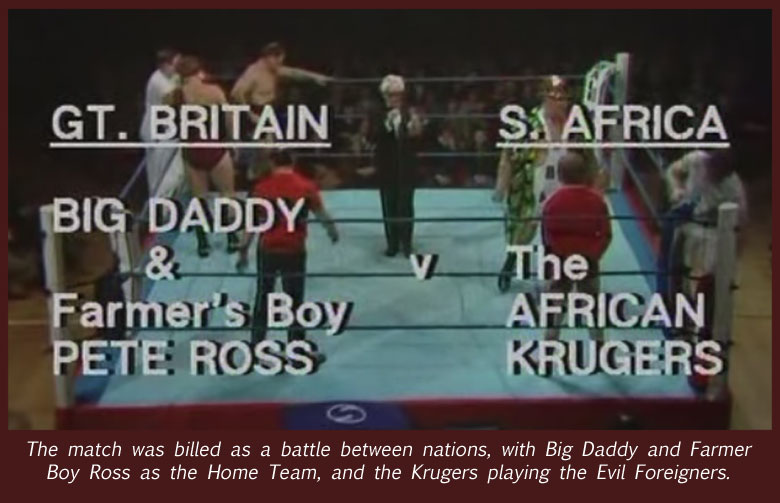
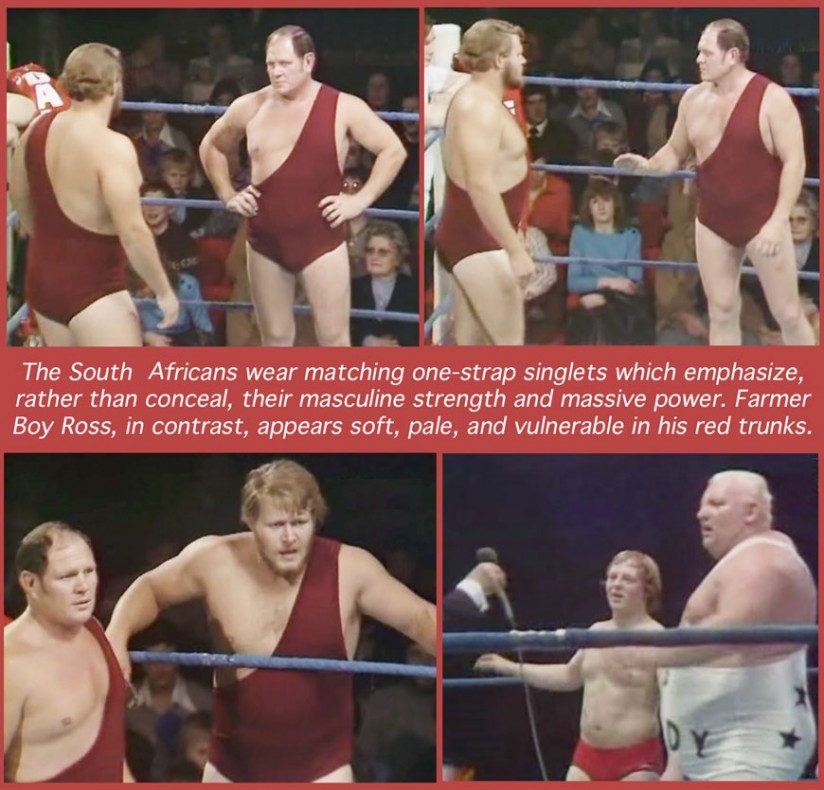 One of the most popular “athletes” in classic British Pro wrestling was a massive fat man known as “Big Daddy” — seen here in a bulging white singlet. The fans loved to see him perform, but the problem was that he was too huge and out of shape to get in the ring and wrestle for 20 minutes. Once in the ring, he couldn’t do much beyond belly-bucking his opponent and then falling on him to crush him. He was barely able to move about, but the fans loved him never-the-less and would eagerly pay good money to see him.
One of the most popular “athletes” in classic British Pro wrestling was a massive fat man known as “Big Daddy” — seen here in a bulging white singlet. The fans loved to see him perform, but the problem was that he was too huge and out of shape to get in the ring and wrestle for 20 minutes. Once in the ring, he couldn’t do much beyond belly-bucking his opponent and then falling on him to crush him. He was barely able to move about, but the fans loved him never-the-less and would eagerly pay good money to see him.
So what to do? Do we put this popular Side Show Freak in the ring and risk him falling over of a heart attack just to sell more tickets?
The solution to this dilemma was to pair Big Daddy with a young Baby-Face, and put the kid in the ring first. This way, the Heels could torture the Baby-Face-in-Peril for about 19 minutes while Big Daddy leaned on the ropes panting and looking angry. Then the Face could make a hot tag and Big Daddy would fall on the opponent and win the match in the final minute. The fans still could witness their beloved Big Daddy in action without him having to work beyond a minute or two. This was a perfect solution for everyone involved — except for the whipping boy chosen to serve as Daddy’s partner!
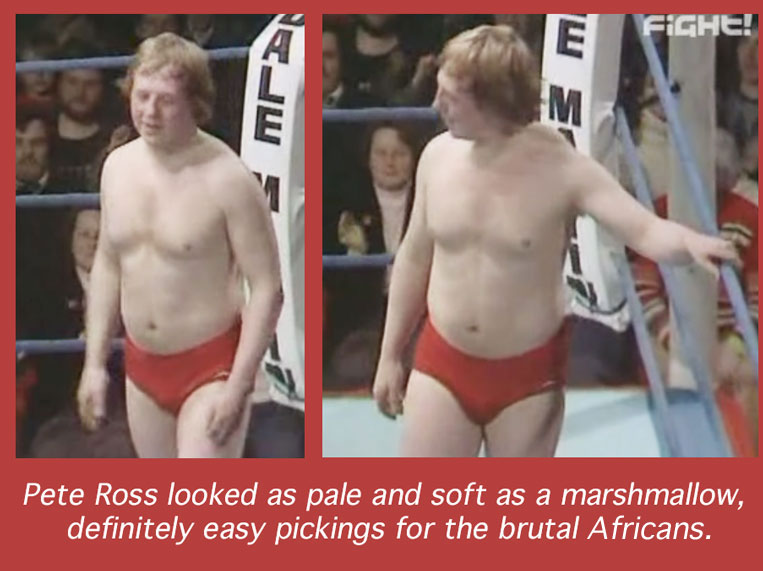 One frequent partner for Big Daddy was “Farmer’s Boy” Pete Ross. This pale jobber had a soft, pillowy body that was just begging to be stomped and tortured. As if he didn’t look effeminate enough, they dressed his fish-belly white body in bright red panties that emphasized his private parts. His role was to appear helpless and hurting so the fan-favorite, Big Daddy, could come to his rescue and save the day.
One frequent partner for Big Daddy was “Farmer’s Boy” Pete Ross. This pale jobber had a soft, pillowy body that was just begging to be stomped and tortured. As if he didn’t look effeminate enough, they dressed his fish-belly white body in bright red panties that emphasized his private parts. His role was to appear helpless and hurting so the fan-favorite, Big Daddy, could come to his rescue and save the day.
The term “Farmer’s Boy” not only implies that he is young and innocent (i.e., a “Boy”) but also that he is a bit of a hayseed or rube — a “Farmer.” His nick-name implies that he’s unsophisticated, fresh off the turnip truck — that he comes from a small town or rural community and doesn’t know about the wild, fast, dangerous lifestyle of the big city. He is vulnerable not only because his body is soft and childlike, but also because he is naive and inexperienced, a bumpkin ready to be exploited if not protected by his “Daddy.”
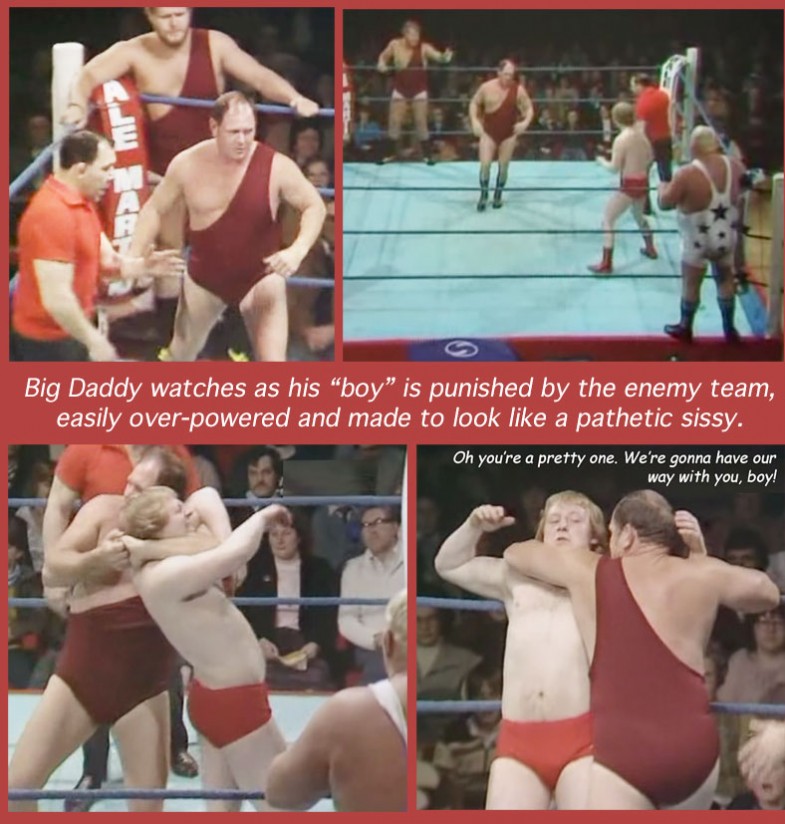
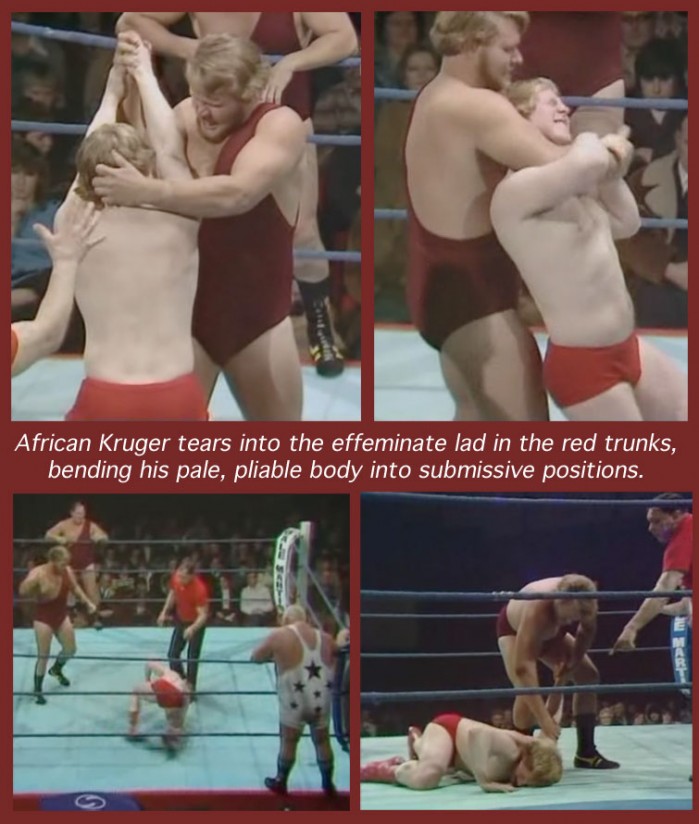 I must say, I dig the matching outfits on the Heel team — the dreaded South Africans. They look like a pair of savage Neanderthals in those one-shoulder-strap singlets, ready to rip apart some soft white gazelle meat. The unusual costume also gives them an exotic or foreign feel — they clearly aren’t from Around Here, from Merry Old England.
I must say, I dig the matching outfits on the Heel team — the dreaded South Africans. They look like a pair of savage Neanderthals in those one-shoulder-strap singlets, ready to rip apart some soft white gazelle meat. The unusual costume also gives them an exotic or foreign feel — they clearly aren’t from Around Here, from Merry Old England.
The villains — African Rand and African Kruger — are a pair of white guys from South Africa, so they’re probably racist and practice Apartheid — the policy of discrimination! They should be punished for that, those despicable bigots! (American wrestling fans may recall one Colonel DeBeers who also cashed in on the South African heel gimmick…) But instead of getting the punishment they so richly deserve, these racist bastards are given a pale weakling jobber to play with like a shiny new toy.
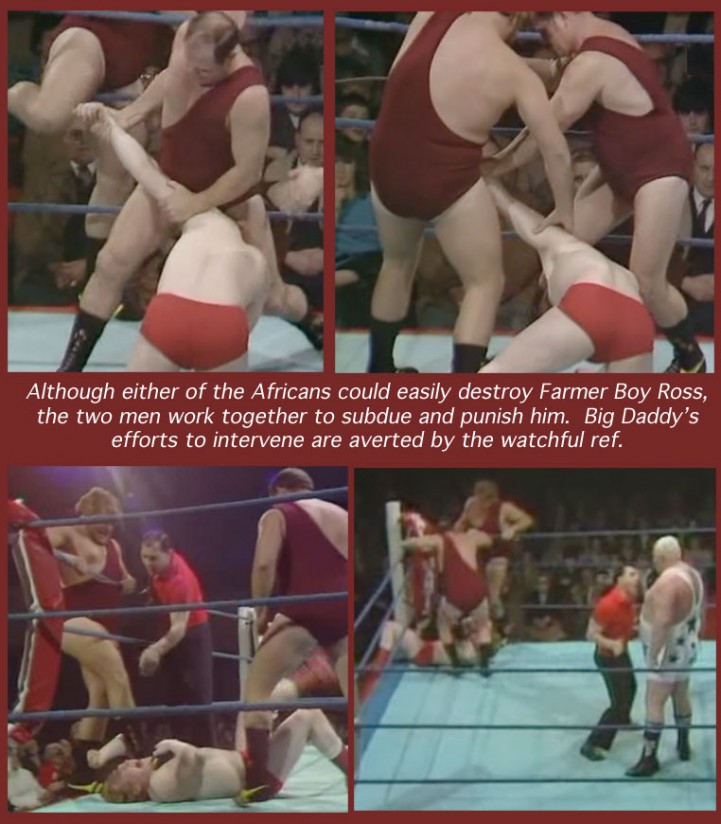
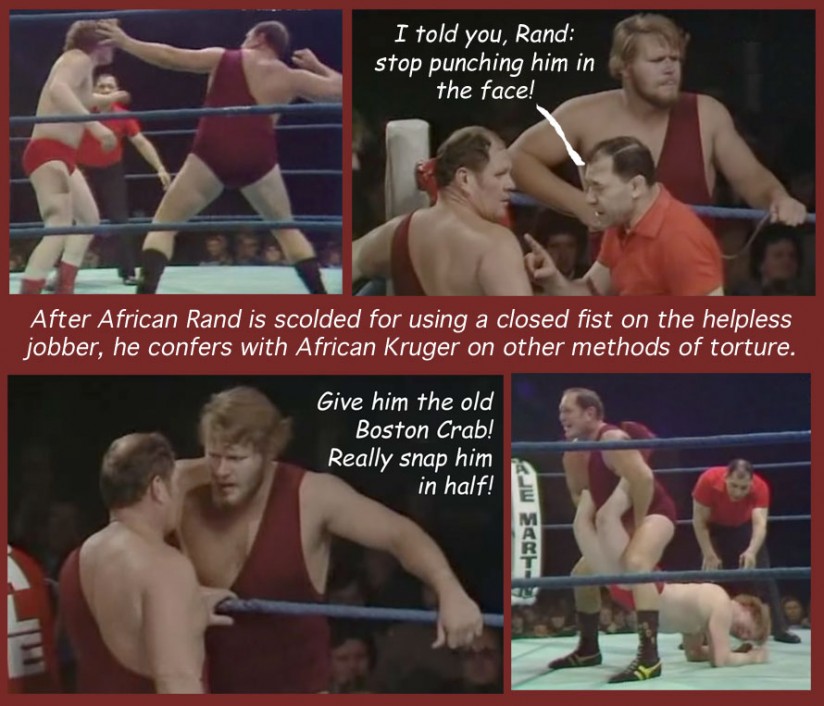
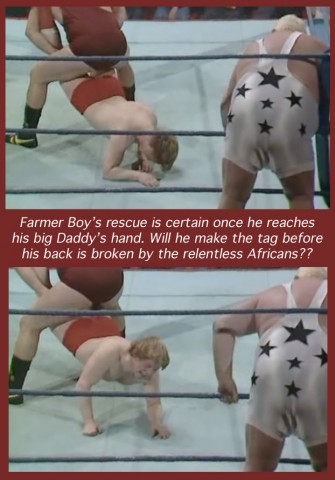 Big Daddy can be seen reaching for a tag, trying to rescue the “Farmer’s Boy.” The contrast in their names — “Daddy” and “Boy” — further highlights the contrast in their size and strength.
Big Daddy can be seen reaching for a tag, trying to rescue the “Farmer’s Boy.” The contrast in their names — “Daddy” and “Boy” — further highlights the contrast in their size and strength.
“Daddy” is a slang term for an older gay man involved in a relationship with a younger, submissive partner. The age gap may differ, but the relationship involves the traditional parental hierarchy of father-son dynamics — the “daddy” provides support and guidance along with sexual encouragement to the inexperienced and vulnerable partner, who is known as the “Boy” or “Boi.”
The interplay of strong, protective daddy with adoring, obedient boy uniquely combines feelings of love, power, and masculinity in exciting ways, so that “Daddy-Boy” role-play is known to be one of the most popular scenarios in gay culture. It’s not that everybody is turned on by daddy/boy fantasies, but we can all locate ourselves along the spectrum of being, having, or wanting a good Daddy.
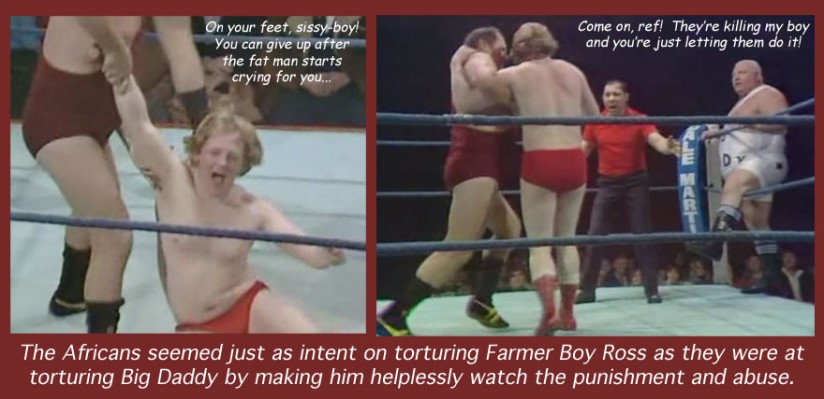 Calling one partner “Daddy” and the other “Boy” may imply that these two partners are a gay couple in the classic Daddy/Boi relationship. Seeing the Farmer’s Boy helplessly reaching for a tag — desperate to be rescued by his Big Daddy — plays off the Daddy-Boy dynamics that many men seem to crave. Big Daddy is confident and powerful — the masculine ideal. The Farmer’s Boy, in contrast, is eager to please Big Daddy, wrestling the best he can, but easily over-powered by the stronger, more masculine Africans.
Calling one partner “Daddy” and the other “Boy” may imply that these two partners are a gay couple in the classic Daddy/Boi relationship. Seeing the Farmer’s Boy helplessly reaching for a tag — desperate to be rescued by his Big Daddy — plays off the Daddy-Boy dynamics that many men seem to crave. Big Daddy is confident and powerful — the masculine ideal. The Farmer’s Boy, in contrast, is eager to please Big Daddy, wrestling the best he can, but easily over-powered by the stronger, more masculine Africans.
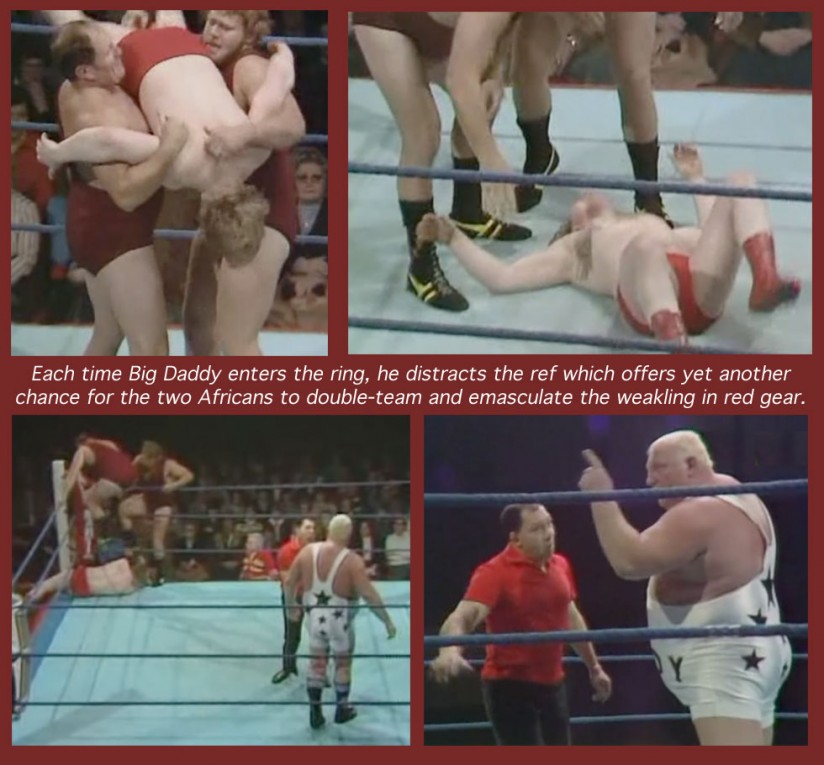
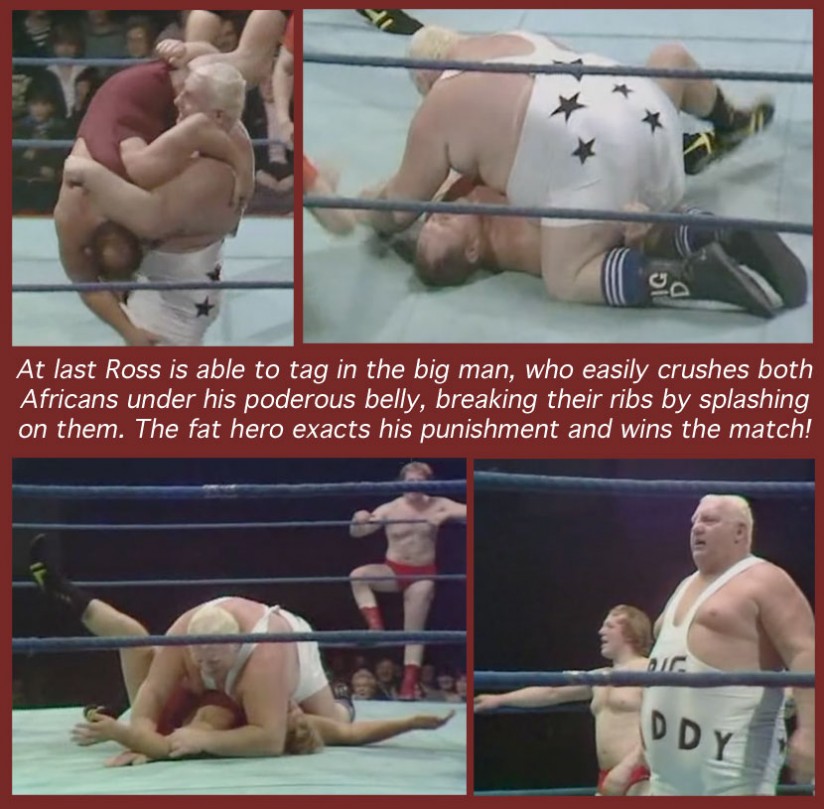
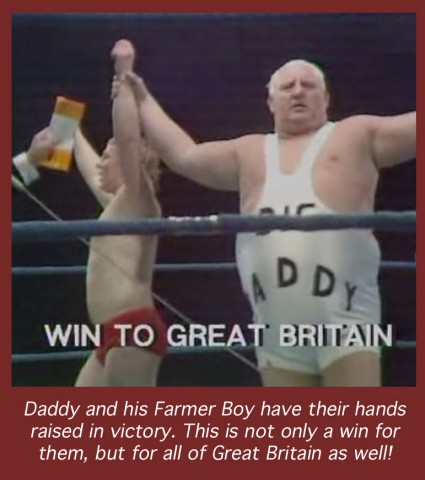 The submissive men in the audience who crave a “Daddy” figure, a confident Alpha Male to protect and nurture them, can easily identify with poor little Pete Ross. They enjoy witnessing the eventual rescue of the poor “Boi” by the powerful, unbeatable, loving Big Daddy, who can’t stand to see his Boi suffer. The appeal and popularity of a big fat unexciting wrestler like “Big Daddy” is revealed when we realize that he represents the masculine ideal, the daddy that so many men in the audience crave.
The submissive men in the audience who crave a “Daddy” figure, a confident Alpha Male to protect and nurture them, can easily identify with poor little Pete Ross. They enjoy witnessing the eventual rescue of the poor “Boi” by the powerful, unbeatable, loving Big Daddy, who can’t stand to see his Boi suffer. The appeal and popularity of a big fat unexciting wrestler like “Big Daddy” is revealed when we realize that he represents the masculine ideal, the daddy that so many men in the audience crave.
Although the Daddy/Boy dynamic is most apparent and obvious in this match, the same dynamic plays out in many Tag Team scenarios where one partner is dominant.
